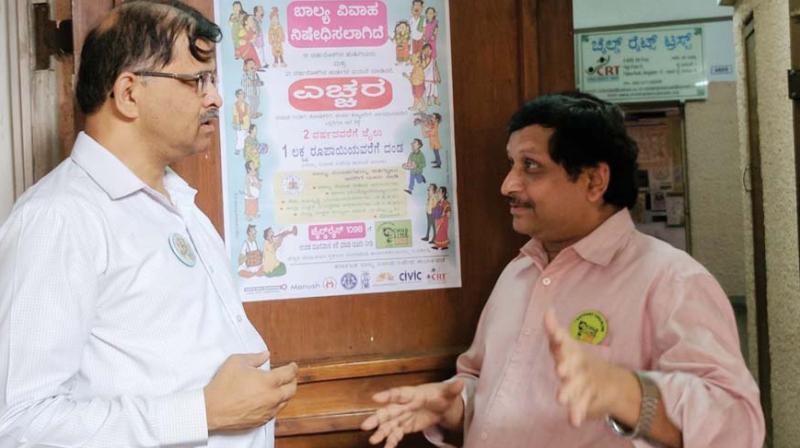The chat room: Socio-cultural aspects make child marriage a complex issue

As the entire country is lauding the Supreme Court order on the Prohibition of Child Marriage Act, child rights activists believe that nullification of child marriage is not the only step that should be taken. G. Nagasimha Rao, Director, Child Rights Trust, and Vasudeva Sharma, an RTI activist, discuss with Joyeeta Chakravorty the necessity of proper education and strict punishments against offenders to stop the menace.
The Supreme Court’s landmark judgment on Wednesday brings long overdue respite to Indian women, who have had little voice with regard to social evils like child marriage and marital rape. So far, the importance of consent has been greatly diluted and compromised by the binding laws of marriage in Indian society, with little regard given to the sexual violence millions of women undergo in silence, in the supposed sanctity of their own homes.
The judgment has been greatly lauded across the nation but Child Rights activists believe that a mere ruling will not make a real change in the harsh realities of daily life. A true change, they agree, requires education, proper implementation of the law and speedy, strict punishments. Karnataka’s pioneering amendment to the Prohibition of Child Marriage Act (PCMA), which received praise from the Supreme Court, is a good example of this. The amendment declares child marriage automatically null and void, despite which the phenomenon remains rampant across the state.
G. Nagasimha Rao, Director, Child Rights Trust has continued to emphasise the frequency of child marriages, even amongst the migratory population living on the outskirts of the city. “We welcome the judgment but it cannot be said that the battle against child marriage has been won. Victory is nowhere close by, even. There is a dire need for awareness, within the judicial system and at the grassroots too. We should bear in mind always that when a girl child is married off, her life is effectively over.
Rao and Sharma were actively involved in the PCMA amendment too. “We were one of the intervenors in the case, along with Jayna Kothari, Executive Director, Centre for Law and Policy Research,” said Sharma. “We provided the case studies and interpretations of the Karnataka amendment to the Prohibition of Child Marriage Act 2006. The amendment brought into force in April 2017 has declared these marriages void ab initio – invalid from the start – in the hope of eliminating the practice,” he explained. The amendment is now equipped with foolproof provisions, which helps discourage the practice. The addition of one year’s imprisonment for a man who marries a minor is another measure to help curb the problem. The presence of a foolproof law, however, doesn’t amount to much with stern implementation.
Child marriage is a complex issue, with several socio-cultural and economic aspects that need to be considered if the practice is to be eradicated. “One of these factors is the fear psychosis among parents, who believe their daughters will be misused or abused. They are also afraid that their girls will elope. In many cases, these are relevant, real fears,” says Sharma, adding, “Marriage in India is seen as the start in the development of a relationship and sadly, the girl becomes a pawn.” The amended Bill seeks to ensure zero tolerance towards child marriage, granting additional powers to policemen and enhancing penalties even for those who attend the wedding ceremonies of minors. While the original legislation doesn’t prescribe a minimum punishment for offenders, the amendment proposes rigorous imprisonment of one year. It also enables the police officer to take cognizance of the offence.
Marriage was once a solution to a number of family woes, from economic security to the well being of women at a time when little else could be done to ensure their safety. Much has changed since and marriage is no longer the only recourse. How much credence should be given to ultra-local cultural beliefs in a society where diversity is the norm?
“The law has not been brought out as a reponse to a social situation alone. Judgments of this nature are not made in that way – a great deal of thought goes into a single ruling,” argued Sharma. “The responsibility now rests with the government, which needs to publicise the law at the state and national levels.
The government needs to set aside a budget to spread awareness, which is more than just Information, Education, Communication (IEC). It’s about building an information resource, with an organised network of officials whom people can contact in times of need. Otherwise, how will a girl know her rights? Prevention, Protection, Provision and Participation are hte four pillars of child rights and welfare and need to be implemented at every level,” stresses Rao.
"Government, police and the community have to be educated at the local level. The government should ensure that people working with the Child Rights department are not threatened or manhandled by local goons and that law is implemented. It is the reality, child rights officials are abused and manhandled. Let’s implement the law and take the girl child seriously," sums up Mr Vasudev.

